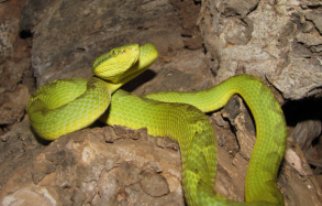Reproduction
Mating:
Pit vipers reproduce sexually by means of internal fertilization.
To do this the male penetrates the female with the hemipenes
organ at the base of his tail. No specific rating ritual has
been seen between the males and females, though males are known
to sometimes fight for the right to mate with a female.
Snakes are solitary animals, so the male leaves soon after
mating and does not share any responsibility with the young.
The miracle of birth:
 Pit Vipers are classified as ovoviviparous. This means
the female produces eggs, but they hatch inside the female and
thus she gives birth to live young. This is unusual in the
Reptile class of organisms, a feature unique to certain families
of the Squamata order.
Pit Vipers are classified as ovoviviparous. This means
the female produces eggs, but they hatch inside the female and
thus she gives birth to live young. This is unusual in the
Reptile class of organisms, a feature unique to certain families
of the Squamata order.
The litter size of the pit vipers varies, but is typically 4
to 5 young. Variation in litter size can be caused by both genetic and environmental factors.
Studies have shown that females with a larger mass and more
energy reserves will give birth to a larger litter.
Likewise, in regions where resources are plentiful, larger
litter sizes have been observed then in regions suffering from
drought or other environmental factors.
Young:
Young pit vipers are around 18cm in length and tend to exhibit brighter color scales,
especially at the tail. The brighter colors are used to
attract frogs and other prey. The young are also
venomous and able
to hunt on their own, and are therefore independent of the
mother, who leaves soon after birth.
See what kind of interactions the
Bamboo pit vipers have
Go back home